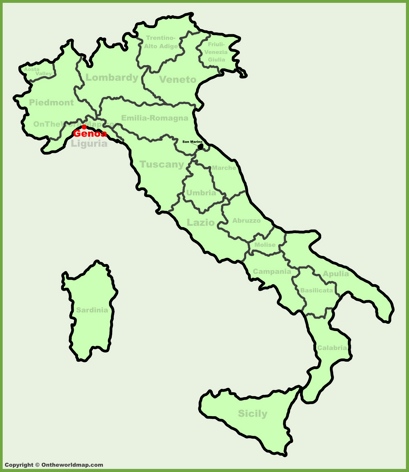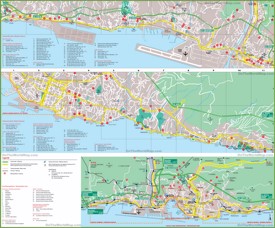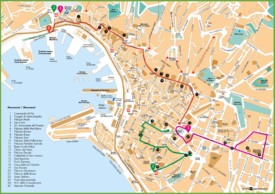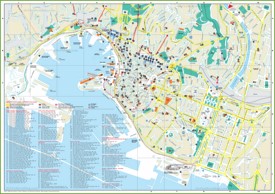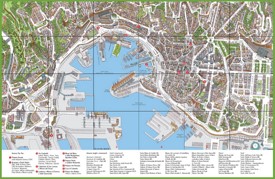Genoa Maps
Online Map of Genoa
About Genoa (Genova)
Genoa, known as Genova in Italian, is a significant port city in northern Italy. It serves as the capital of the Liguria region and is situated along the Ligurian Sea. The city lies in a narrow coastal strip between the Apennine Mountains and the sea, providing it with a unique and picturesque landscape. As of the latest estimates, Genoa has a population of 562,836 (2024) residents. The city is characterized by its diverse and multicultural population, contributing to its dynamic and cosmopolitan atmosphere.

Genoa has a rich history that dates back to ancient times. It was an important Roman town and became a powerful maritime republic in the Middle Ages, along with Venice, Pisa, and Amalfi. The city's strategic location facilitated its growth as a major hub for trade and commerce in the Mediterranean region. During the 12th and 13th centuries, Genoa was a formidable naval power and played a crucial role in the Crusades.
Genoa boasts a rich architectural heritage, with numerous landmarks that reflect its historical importance. The city's historic center, known as the "Centro Storico," is one of the largest in Europe and is a UNESCO World Heritage Site.
Genoa offers a wealth of attractions that reflect its rich history and culture:
Historic Center (Centro Storico): One of the largest medieval city centers in Europe, known for its narrow alleyways, squares, and palaces. The area is filled with cafes, shops, and restaurants.
Palazzi dei Rolli: A collection of palaces that are part of a UNESCO World Heritage Site. These buildings, constructed between the 16th and 18th centuries, served as residences for noble families and high-ranking visitors to the city.

Aquarium of Genoa (Acquario di Genova): One of the largest aquariums in Europe, located in the city's old port. It features a vast array of marine life and ecosystems.
Genoa Cathedral (Duomo di Genova, Cattedrale di San Lorenzo): The main cathedral of Genoa. It is dedicated to St. Lawrence and is the seat of the Archbishop of Genoa. The cathedral was consecrated by Pope Gelasius II on October 10, 1118 and was built between the 12th and 14th centuries as a medieval building with later additions. The side aisles and ceilings are Romanesque, while the main facade is early 13th century Gothic and the nave columns date from the early 14th century. The bell tower and dome were built in the 16th century.

Doge's Palace (Palazzo Ducale): A historic palace that served as the residence of the Doges of Genoa. Today, it hosts exhibitions, concerts, and cultural events.

Galata Maritime Museum (Galata Museo del Mare): A museum dedicated to the maritime history and culture of Genoa. It features exhibits related to seafaring, shipbuilding, and maritime trade.
Piazza De Ferrari: The main square of Genoa. It is located between the old town and the modern business center. There is a fountain in the middle of the square, along with the Lanterna lighthouse, one of the symbols of the city.

Genoa is renowned for its vibrant cultural scene. The city has a rich musical heritage and is the birthplace of the renowned violinist and composer Niccolò Paganini. Genoa also hosts several cultural events and festivals throughout the year, including the Genoa International Boat Show and the Genoa Film Festival.
The University of Genoa, founded in 1481, is one of the oldest universities in the world. It offers a wide range of programs and is recognized for its research contributions, particularly in fields such as engineering, medicine, and marine sciences.
Genoa is well-connected through various modes of transportation. The city has an extensive public transport system, including buses, trains, and a metro line. The Genoa Cristoforo Colombo Airport provides domestic and international flights, enhancing the city's connectivity.
Genoa is a city that seamlessly blends its rich historical past with modern economic and cultural vitality. Its strategic location, historical significance, and diverse offerings make it a fascinating destination and an essential part of Italy's heritage and economy.
The Facts:Region: Liguria.
Province: Genoa.
Population (2024): 562,836.[1]
Area: 92.78 sq mi (240.29 sq km) .
Postal code: 16121-16167.
Dialing code: 010.
Website: comune.genova.it
References
1. Demografia in cifre. Italian National Institute of Statistics.Maps of Italy
Cities of Italy
Cities of Italy
Regions of Italy

